It is a fact that nearly everybody, even the least observant person , has a precise, albeit mistaken, idea of what they look like. As a rule, they are dissatisfied with nature’s product. They may be unsympathetic to their reflection in the mirror; they may scorn their photographic image. Although their objections may not always be justified, their insistence on superrealistic likeness is understandable. They ask for more than artistry or resemblance; in fact, resemblance may be the last thing they want. To shore up their ego, they need an icon, a holy picture of his inner self. Only a faultlessly constructed mask will meet their need- and gain their approval…
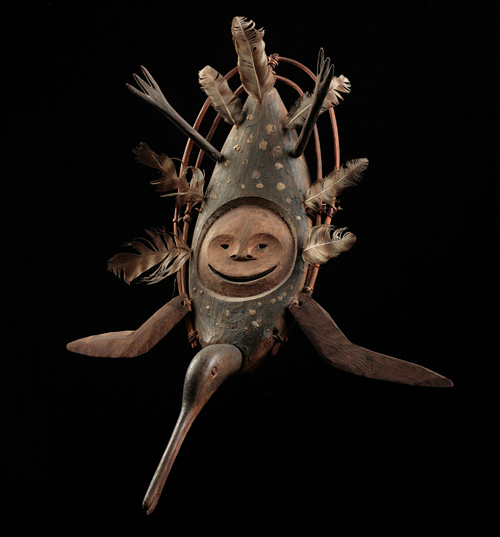
Joy Garnett: Collector Robert Lebel, the writer and biographer of Marcel Duchamp, was a friend of surrealist poet André Breton, and both men shared a passion for Eskimo art, which they collected during their exile in America in the 1940s. They bought mainly at the New York gallery of Julius Carlebach, which Max Ernst discovered when he stopped in to try to buy a Haida spoon. When Lebel, Breton and other surrealists were collecting this type of art in the ’40s, it was virtually unknown to the market. They introduced it to Paris when they returned after World War II. read more: http://newsgrist.typepad.com/robertgoldwaterlibrary/auctions/
An unassuming person might be content with a single mask , modeled after his most flattering photograph- perhaps the one they have chosen to accompany their obituary. Or, they might settle for an idealized likeness of themself, a sublimation of ordinary features. A truly fastidious person might want to own an entire collection of masks, each suitable for a particular occasion, expressing optimism, indifference, sustained surprise, displeasure etc., without jeopardizing their basic looks. A person who has been mistaken more than once for a celebrity whom he faintly resembles might unblushingly choose the illustrious face. No doubt, most people would want to look younger; a few, perhaps, older. But rare is the person who has never longed to encounter a different face in the mirror.
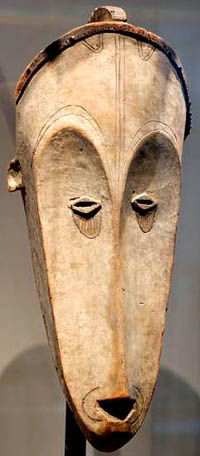
Dali House: Modern art’s fascination early in the last century with so-called primitive art chagrined Salvador Dali to the tweezer-tips of his moustache. He was appalled that Picasso and the cubists and, worse, his fellow surrealists André Breton, Paul Eluard and Louis Aragon, could derive inspiration from “savage” artisans. But he must have recognised the parallel. In their anguished and grotesque imagery, the surrealists in particular were evoking the same monsters of the subconscious that tribal shaman recruited for their ends. read more: http://dalihouse.blogsome.com/2009/06/21/unmasked-colonialism-and-its-rewards/
A mask permits anyone to put his best face forward. No baggy eyes, no wrinkles, no five o’clock shadow, all features permanently composed. Neurologists may want to prescribe therapeutic masks to help patients ease their real or imagined sufferings. At a board meeting a well-masked person will not hesitate to speak their mind freely, and the steady gaze of his fellow masks will fill him with pride and confidence.
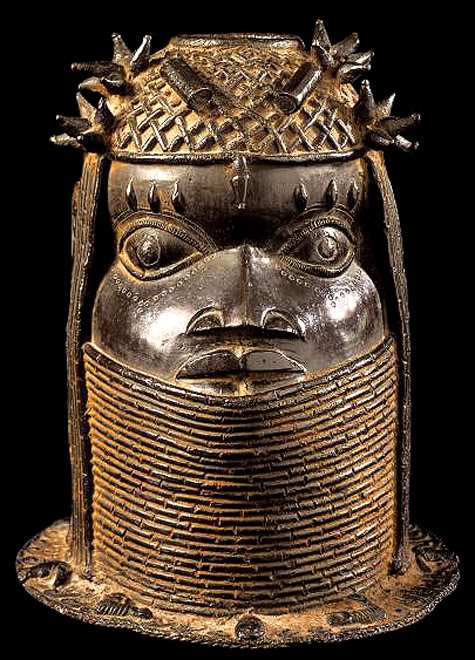
"From the 14th to 18th centuries, when a monarch — an oba — died in the Kingdom of Benin, in what is now Nigeria, his would-be successor had two bronze heads made, one in the late ruler’s likeness and one in his own. They were placed on a purpose-built altar, face to face, each surmounted by an ivory tusk engraved with commemorative scenes. Thus the new oba established the bond of continuity with his predecessor, legitimatising his own rule. This example was on auction last year for €400,000." read more: http://dalihouse.blogsome.com/2009/06/21/unmasked-colonialism-and-its-rewards/
Moreover, since few men in the public eye are graced with a handsome or intelligent face, a mask can alleviate the discomfort of having to look at them. It has been ascertained that much of the poor impression politicians make results from their visual image. Henceforth, popularity votes and personal ratings will be based on a person’s compelling effigy; by wearing a mask they will no longer have to show the world their true face. Sculptors, those least useful members of human society , will receive commissions that may decide a nation’s fate, and news will be made by the ten best masked men and women, whether they wear clothes or not.
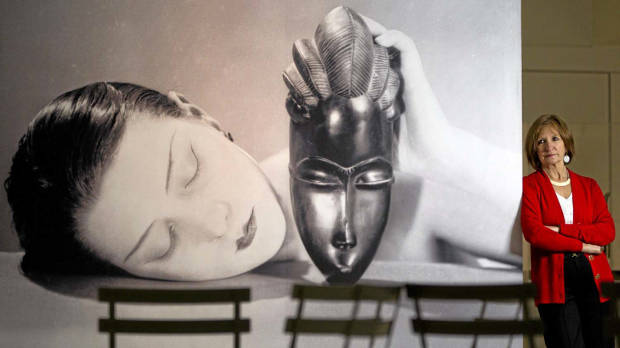
Marsha Lederman:Man Ray’s Noire et blanche is a masterpiece of contrasts: the soft, white face of his muse Kiki, her head horizontal, her eyes closed. She is holding an African Baule mask: vertical, dark, hard. Originally shot for a 1926 edition of Paris Vogue, the photograph has certainly become one of the most iconic examples of avant-garde photography, if not modern art, period. Noire et blanche has always been considered a departure for Man Ray: a rare dance for the modernist with African art. Not so, it turns out. ... read more: http://www.theglobeandmail.com/news/arts/in-vancouver-a-revolutionary-look-at-man-ray/article1778194/
ADDENDUM:
Is the Shroud of Turin a mask? Is there a line between old masks and old artifacts of Western religion, like Russian Orthodox icons, centuries-old menorah and mediaeval liturgical vestments? These too are imbued with sacredness, as much as any native North American totem, and they’re eminently collectible too, as are old copies of the Bible and the Qu’ran.
I’d love to see a chart comparing the relative value of the tribal-mask market with that of, for example, football jerseys or baseball cards. These days we collect anything. It’s just that, usually, they are the things of the modern world produced within our own culture. Read More: http://dalihouse.blogsome.com/2009/06/21/unmasked-colonialism-and-its-rewards/ a
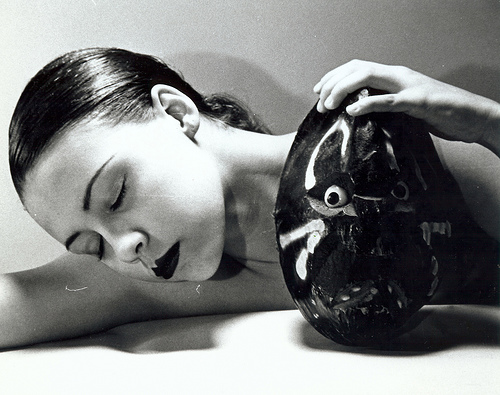
Lederman:Man Ray – a chess aficionado – did not simply document these artifacts, she realized. His photographs radically transformed them, or at least transformed the viewer’s experience of them. Illustrating this became one of Grossman’s chief objectives; the relationship between the three-dimensional object and the two-dimensional image a central part of her exhibition experience. A tiny sculpture might become large and menacing in Man Ray’s photograph, the artist playing with light, shadow and perspective to create a work of art from a work of art. ... read more: http://www.theg
andmail.com/news/arts/in-vancouver-a-revolutionary-look-at-man-ray/article1778194/page2/“The cubists had wanted to make use of the plastic solution which was offered by African masks (Artistic Cultures of sub-Saharan Africa); the surrealists, on the other hand, tried to establish communication with the mind that had imposed the form of the mask. The first twentieth-century amateurs of what were called ‘barbaric fetishes’ were as willing to collect rubbishy tourist souvenirs as authentic pieces. In 1905 Vlaminck and Derain were wholly undiscriminating in the purchase of objects which sailors had brought back from Africa. The surrealists made their choices as genuine connoisseurs; some of them, indeed, were specialists in ethnography….
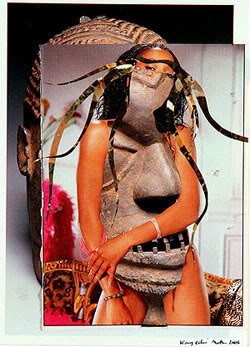
Wangexchi Mutu. " “Mask”, 2006, archaic sculpture and modern tease. Goddesses and glamour models there are, but they’ve clearly just been released from hospital following a horrendous accident. Their skin is inhuman and they’re at least partially bionic, not in a good way. They are very much science fiction, but as we always discover once we get there, the future isn’t clean and stable — it’s a junkyard of the past. Our robots aren’t going to be young, curvy, soft-skinned Japanese handmaidens; they’ll be brides of Frankenstein, with serious issues that, like the glitches in Windows software, refuse to be resolved." read more: http://dalihouse.blogsome.com/2008/04/
…The time which many of the surrealists spent in America gave them the opportunity of discovering American Indian art, which moved them to the same enthusiasm as the art of Oceania. The traces of pre-Columbian civilizations, too, evoked a ‘lost world’, and they too were probed to give forth their meaning. Max Ernst and Andre Breton, particularly, were captivated by the myths and drawings of the North American tribes; for example by the Hopi of north-east Arizona, with the wall paintings in their kivas, underground temples, their initiation rituals which culminated in the ‘night of mystery and terror’, their cult of cloud-ancestors, and their supernatural guardians the Katchina, who were represented by dolls or by masked dancers.” read more: http://www.all-art.org/history580-3_Surrealist_Art1.html
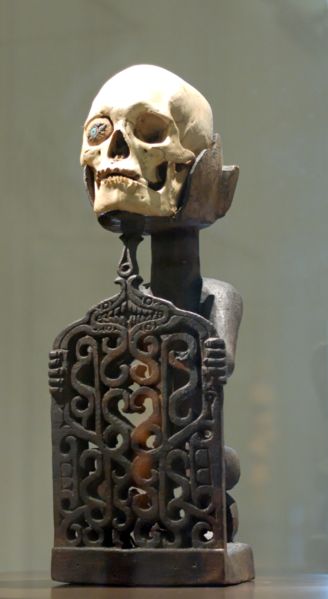
Dylan Thomas Hayden:Three rude and hasty translations of poems from André Breton’s collection Xénophiles. These poems were clearly inspired by the New Guinean sculpture which held a life-long fascination for Breton. I have tried to reunite the poems with their sources. The Korwar sculpture pictured may well be the one the poet saw, as it resides in the Louvre and fits the poem well. Breton owned a fine example of an Uli, or memorial figure but the available photographs of it are of rather poor quality. Dukduk was a secret society among the Tolai people of Papua New Guinea. Its members extorted money, particularly from women, disguised as spirit beings in a costume of leaves and a conical mask. read more: http://tigerloaf.wordpress.com/tag/andre-breton/page/2/
KORWAR
You hold like no other
You were taken as if you were leaving life
To re-enter it
I don’t know if it is in one sense or the other that
you shake the park railing
You have raised again the serpentine grass against your heart
And forever fastened the birds of paradise from the raucous sky
Your glance is extra-lucid
You are seated
And we also are seated
The skull again for some days
All our acts are before us
At arm’s length
In the tendril of the vine of our little ones
To us you yawn it beautifully over existentialism
You are not bitten by worms. read more: http://tigerloaf.wordpress.com/tag/andre-breton/page/2/
Andre Breton, Surrealist Manifesto: “The countless kinds of Surrealist images would require a classification which I do not intend to make today. To group them according to their particular affinities would lead me far afield; what I basically want to mention is their common virtue. For me, their greatest virtue, I must confess, is the one that is arbitrary to the highest degree, the one that takes the longest time to translate into practical language, either because it contains an immense amount of seeming contradiction or because one of its terms is strangely concealed; or because, presenting itself as something sensational, it seems to end weakly (because it suddenly closes the angle of its compass), or because it derives from itself a ridiculous formal justification, or because it is of a hallucinatory kind, or because it very naturally gives to the abstract the mask of the concrete, or the opposite, or because it implies the negation of some elementary physical property, or because it provokes laughter. … read more: http://www.scribd.com/doc/186128/Manifesto-of-Surrealism-Andre-Breton





 COMMENTS
COMMENTS